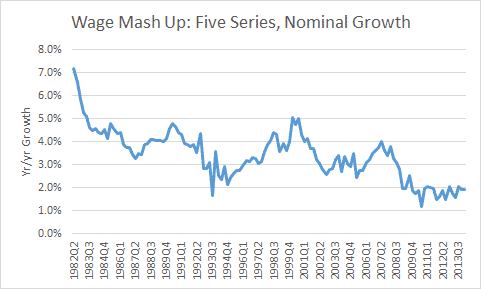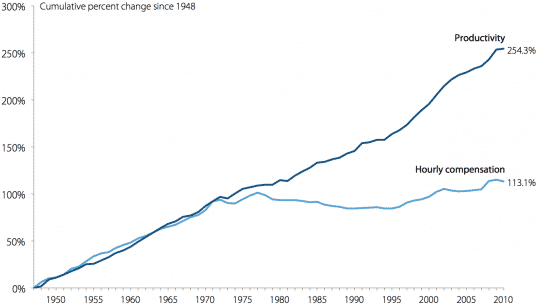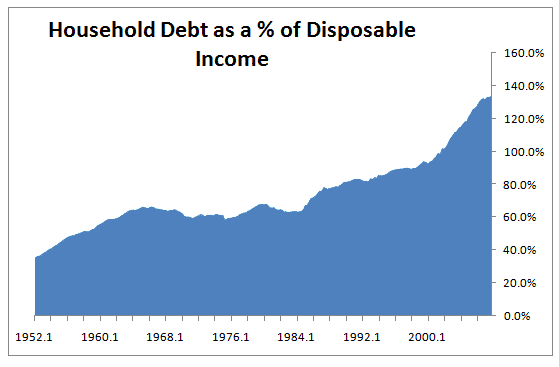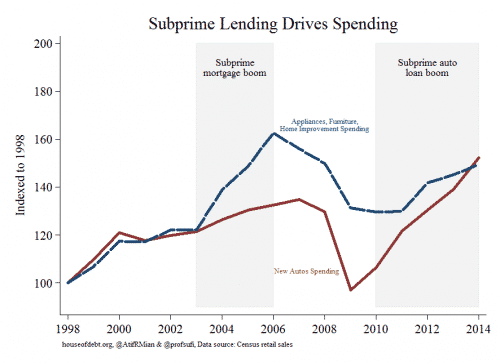Household debt versus wage growth in the United States
The economic and business paradigm in place in the United States is predicated on a secular increase in household debt that I believe will not last through another cyclical downturn without serious deleveraging. The reason we saw deleveraging during this past downturn was because we are now at a point where the secular increase in household debt has become unsustainable. Some thoughts below
Let’s start with this chart from Jared Bernstein:

The secular decline in nominal wage gains is not just a function of declining inflation. Rather, it is a sign of stagnant median wages in the US despite stellar gains in productivity.

This is similar to the economic paradigm the Germans have used to lift the German economy. In Germany, wage restraint has led to a decline in relative wage costs within the eurozone fixed currency union, making German workers more competitive and raising the ability of German firms to export. The result at first was a soft depression in Germany due to stagnant internal demand. But as the euro formed, we saw a sort of vendor financing dynamic take place, allowing Germany to export its way out of stagnation. The key here is that to raise economic growth, the Germans had three choices: allow wages to grow, allow household debt to grow or export. In the German case, exports were the way out.
In the US, confronted with the same lack of wage growth, households took on debt. And this has sustained economic growth in the US. And it has done so for a generation. When I took a brief look at the Asset-based Economy at economic turns five years ago, the secular increase in household debt showed a higher slope from 1982 and an even higher one from 2001.
Prior to the 1970s, US workers saw increasing wages. When real hourly wages slumped in the 1970s, household debt levels flatlined in this period and the increasing participation of women in the labor force kept household income up. But, starting in the early 1980s, the decline of real hourly wages was also counteracted via an increase in debt as interest rates declined and debt service costs became less onerous.
With interest rates at zero percent, the secular decline is over and any increase in household debt will result in a permanent increase in debt service costs that cannot be reduced again via a decline in the Fed Funds rate. The question then becomes whether the incipient releveraging we now see is sustainable through another cyclical downturn.
On that score, a recent post by Amir Sufi and Atif Mian is instructive. They look at the auto subprime sector I have highlighted here in the past. They find that not only does household debt drive spending but that – more narrowly – subprime lending drives spending.
In the chart below, we plot retail spending on appliances, furniture, and home improvement, or “home-related spending” (blue line) and spending on new autos (red line) from 1998 through 2014. We have highlighted the two major subprime lending booms we’ve seen in that period — the subprime mortgage lending boom from 2003 to 2006, and the subprime auto loan boom from 2010 to 2014. In order to be able to include 2014, we focus only on the first four months of each year.
When subprime mortgage lending was booming from 2003 to 2006, so were purchases of home-related goods. As soon as the subprime mortgage lending market crashed, so did home-related spending. In fact, in 2014, home-related spending is still below its 2006 level in nominal terms. It’s a pretty incredible boom and bust.
For auto spending, growth was positive prior to the Great Recession, but unspectacular. But as soon as subprime auto lending heated up in 2011 and afterward, so did purchases of new auto vehicles. The growth in new auto sales from 2011 to 2014 has been really impressive. So once again, spending in a particular market is strongest when subprime lending in that market is strongest.
I believe the Sufi-Mian analysis suggests that debtors with the most precarious economic profiles are the marginal consumption variable in the US. Moreover, given the lack of wage growth, an economic downturn will cause these consumers to experience an unusually large increase in debt stress that will reduce their consumption. And given the subprime consumers’ large marginal propensity to spend, this will mean deleveraging that will induce job losses and a larger deleveraging throughout the economy just as it did with the mortgage sector. Just because the auto sector is less important in terms of credit and spending does not mean the effect will not be palpable.
Add in the serious problems we are seeing in student loans and you have a strong case for a renewed bout of deleveraging. With interest rates at zero percent already, monetary policy will not be a potent force in counteracting this deleveraging, further reinforcing the potential for a subprime auto-student loan enhanced delveraging to create a palpable deleveraging that leads to economic and financial crisis.
P.S. – Ray Dalio is also concerned that monetary policy will be ineffective in this environment.
Also see some brief thoughts on releveraging and wage growth
from February. It would be nice to see releveraging underpinned by wages. Otherwise, it will prove unsustainable.


Comments are closed.